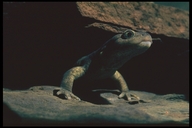|
Description
This salamander has 14 costal groves. Vomerine teeth in two small, arched, transverse rows between the choanae, nearly touching at the midline. Snout broadly rounded; interorbital distance 1.2 times the internasal distance. Limbs well-developed; digits overlapped when adpressed; 4 fingers and 4 toes. Tips of the digits covered with a brown horny epidermis not extending onto the soles and palms. The caudal fin fold begins posterior to hind legs, is highest about 2/3 of the way back. Tail slightly shorter than body. Coloration dark olive-brown to yellowish olive, indistinctly speckled with tiny pigmented dots. The belly is lighter, with fewer dots.
Distribution and Habitat
Country distribution from AmphibiaWeb's database: Afghanistan
Paghman Mountains of the Hindu Kush system, Paghman County, Afghanistan.
The salamander inhabits cool highland streams fed by glaciers. There, the adults occur under rocks in fast-running water, whereas larvae live in deeper and quieter pools, commonly under floating beds of watercress and duckweed. Algae cover most of submerged rocks in the streams. The water temperature in summer varies within 0-14oC. These salamanders were not found in waters above 14o. In contrast to historic observations, the individuals were not common between 2750-3050 m above sea level in 1970s but were only found above these altitudes.
Life History, Abundance, Activity, and Special Behaviors
The salamander is active probably throughout the year because of relatively constant flow of water in the inhabited streams. The high temperature of water may be very important limiting factor of local distribution of this species. The salamanders are completely aquatic. The clutch contains about 30-40 eggs. It is attached onto rock surface in the brook. Only two egg sacs were found in nature (on 6 March 1978). In all probability, larvae overwinter (may be, several times); metamorphosis is known to be in the spring. The larvae and adults prey mainly upon aquatic invertebrates (Gammaridae, as well as larval Trichoptera, Diptera, Coleoptera etc.).
Trends and Threats
The species has a very narrow distribution and ecological niche. Agricultural cultivation of lands near the salamander's brooks and use of water for irrigation drastically change the habitat and lead to shallower depths and increased water temperature. In addition, physical disturbance of the streams comes from pedestrian and animal traffic (sheep, goats, donkeys, horses and camels) in and along streams. The salamanders do not occur in areas of the stream directly affected by irrigation and traffic. Evidence of a more extensive range is indicated in the original species description (Smith, 1940). The collector, Mr. Chaworth-Musters, reported that the salamander was fairly common between the altitudes 2750-3050 m, but observations made in 1977 and 1978 by S.M. Reilly revealed that the species is not very common at those altitudes, but is found higher. In general, the species seems to be highly endangered and virtually unprotected, and its current status may be only supposed due to continuing civil war and other military activities in Afghanistan.
Relation to Humans
See above.
Possible reasons for amphibian decline General habitat alteration and loss
Intensified agriculture or grazing
Drainage of habitat
Comments
When the situation in Afghanistan permits any conservation programs to begin, this species deserves immediate and efficient measures for protection.
References
Reilly S.M. (1983). ''The biology of the high altitude salamander Batrachuperus mustersi from Afghanistan.'' Journal of Herpetology, 17(1), 1-9.
Smith, A.M. (1940). ''Contributions to the herpetology of Afghanistan.'' Annals and Magazine of Natural History, 11(5), 382-384.
Sparreboom, M. (1979). ''Eieren van Batrachuperus mustersi.'' Lacerta, 37(5), 83-88.
Originally submitted by: Sergius L. Kuzmin (first posted 1999-11-10)
Edited by: Michelle Koo, Vance T. Vredenburg (2016-11-07)Species Account Citation: AmphibiaWeb 2016 Paradactylodon mustersi <https://amphibiaweb.org/species/3872> University of California, Berkeley, CA, USA. Accessed Jan 7, 2025.
Feedback or comments about this page.
Citation: AmphibiaWeb. 2025. <https://amphibiaweb.org> University of California, Berkeley, CA, USA. Accessed 7 Jan 2025.
AmphibiaWeb's policy on data use.
|



 Raffaëlli Account
Raffaëlli Account Map of Life
Map of Life